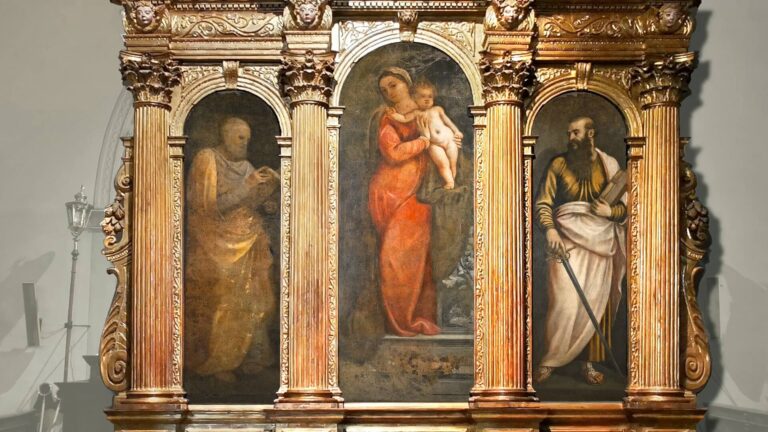ARTISTS’ ROADS
LE VIE DEGLI ARTISTI
watch the videos at the bottom of the page!
SAN FIOR
Titian: A Triptych, a Community, a Home
Titian left the Cadore region when he was less than ten years old. He lived in Venice, first near the Frari, then, from 1530 onward, in Cannaregio. His workshop was in a house overlooking the Rio dei Biri.
It was here that he painted the masterpieces of his maturity and ultimately died of plague in 1576.
But there is another house linked to Titian.
It was a distinguished building with a shingle roof in the centre of Pieve di Cadore, the Vecellio family home, which was declared a national monument in 1922.
Yet nestled in these hills, connecting the Treviso plains to the foothills of the Alps, lies the only house Titian ever built for himself.
This is Villa Fabris, occupying the Col di Manza in the municipality of Colle Umberto.
Although transformed over time, the building can still be described as an elegant rural residence, a modest stately home.
Documents reveal that it was built through barter.
In exchange for building materials and labour, Titian painted a triptych for the high altar of the parish church of San Pietro in Castello Roganzuolo, now a hamlet of the municipality of San Fior.
The year was 1543, and for the next six years, there are records of deliveries of beams, bricks, roof tiles, lime, and even wine for the workers employed there and to send back to Venice.
The community of Castello invested heavily in this exchange but how could they pass up the opportunity to commission a work from the most famous Venetian painter of the time, who was then also painting for Pope Paul III Farnese and Emperor Charles V of Habsburg?
The three canvases were set within a large gilded frame and installed in the presbytery of the parish church.
They even covered the splendid frescoes by Francesco da Milano, completed only ten years earlier.
A powerful testament to how important this work remained for the community of Castello Roganzuolo is found in the darkest days of the First World War.
It was the autumn of 1917, the days of the Battle of Caporetto.
The Austrians were hunting for the triptych, perhaps wanting to enrich the museums of Vienna with this masterpiece by Titian.
But for the community, it was a symbol, something sacred. The parish priest hid the paintings in the attic and chose prison rather than reveal their hiding place.
The artwork was saved but months of rainwater leaking through the attic roof left its mark.
Today, the three canvases can be admired at the “Albino Luciani” Diocesan Museum of Sacred Art in Vittorio Veneto, where even the damage inflicted indirectly by the war is viewed with reverence.
From the parish church of Castello Roganzuolo, Titian would have enjoyed two breathtaking vistas.
To the south, his eyes would have roamed across the Treviso plain, glimpsing, in the distance, the shimmering reflections of the Venetian Lagoon.
To the north, beyond his home on Col di Manza, the view opened onto rolling hills and the serried ridges of the Prealps.
A layered landscape, where vivid colours alternate with soft light, creating moods of clarity or humid haze, those very landscapes that live on, so vividly, in his paintings.
MORE EXPERIENCES!
I Vecellio:
- Duomo di Serravalle
- Arcipretale di Tarzo
- Arcipretale di Fregona
- Museo diocesano d’arte sacra a Vittorio Veneto
MULTIMEDIAL MAP: “ARTISTS’ ROADS – LE VIE DEGLI ARTISTI- EN”!

